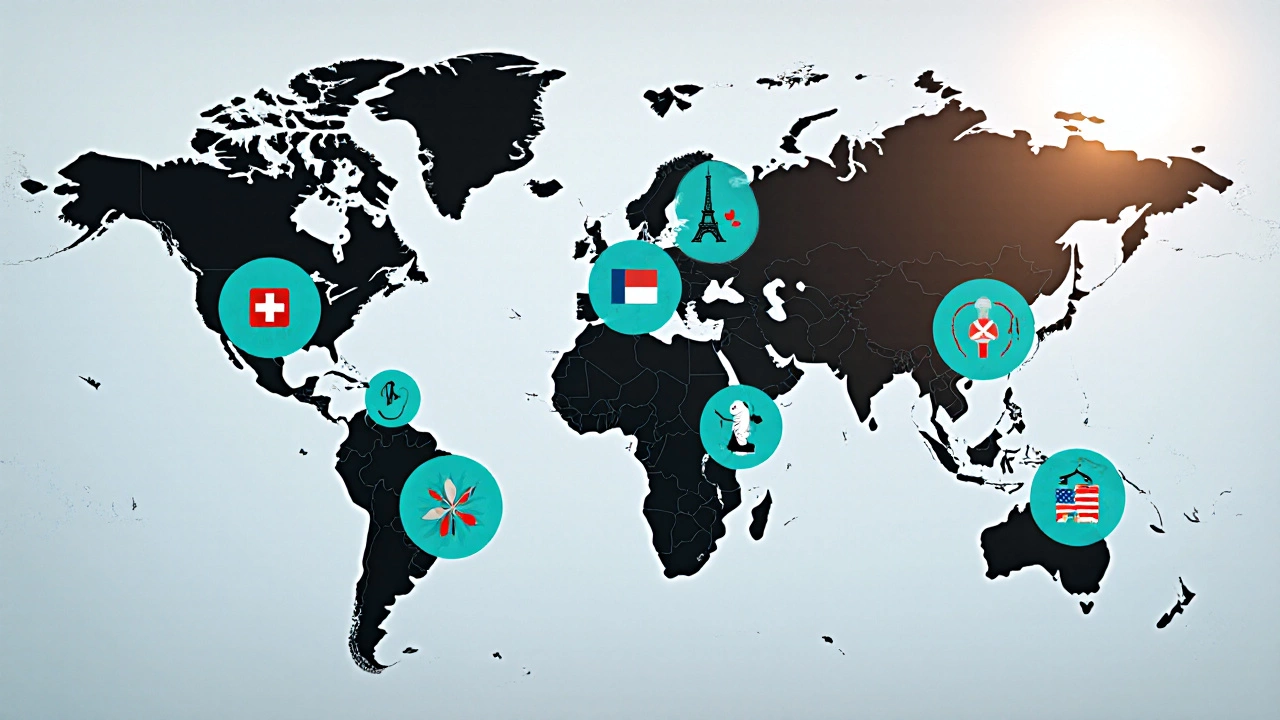 Oct, 12 2025
Oct, 12 2025
Healthcare System Selector
Compare Healthcare Systems by Your Priorities
This tool helps you find the best healthcare system based on what matters most to you. Assign weights to different metrics, and we'll calculate which country best matches your priorities.
Your Priorities
Adjust the weights for each metric to reflect what matters most to you
Results
Based on your priorities, the best healthcare system is:
When you wonder which country has the best healthcare system in the world, you’re really asking about a mix of outcomes: life expectancy, equity, cost, patient satisfaction, and innovation. The answer isn’t a single nation but a handful that consistently outperform their peers. Below we break down the latest data (2024‑2025), explain how the rankings are built, and give you the facts you need to judge each system on its own merits.
Key Takeaways
- Switzerland, France, and Japan lead on overall quality and patient outcomes.
- Singapore and the Netherlands excel in cost‑efficiency and low out‑of‑pocket spending.
- Australia and Canada offer strong universal coverage with relatively modest taxes.
- The United Kingdom provides comprehensive coverage but struggles with waiting times.
- The United States shows high innovation but ranks low on equity and affordability.
How the Rankings Are Calculated
We pulled data from three reputable sources:
- OECD Health Statistics 2024 - life expectancy, preventable deaths, physician density.
- World Health Organization (WHO) Health System Performance Review 2025 - access, equity, and patient‑reported satisfaction.
- Bloomberg Health‑Care Efficiency Index 2025 - per‑capita spending, out‑of‑pocket costs, administrative overhead.
Each metric received a weight (outcomes 40%, access 30%, cost‑efficiency 20%, innovation 10%). Scores were normalized on a 0‑100 scale and summed to produce the final ranking.
Country Profiles
France is a Western European nation whose healthcare system combines universal coverage, high provider density, and strong preventive care. According to the OECD, France’s life expectancy sits at 83.2 years and its preventable mortality rate is one of the lowest in the world (30 per 100,000). Patients report a 92% satisfaction rate, thanks to short wait times for primary care and generous drug reimbursement (average out‑of‑pocket share 12%). Per‑capita spending is €4,900, placing it in the mid‑range for Europe.
Germany offers a statutory health‑insurance model that covers 90% of the population. Life expectancy is 81.9 years, and the system boasts 4.2 physicians per 1,000 residents. Administrative costs are low (about 7% of total health expenditure). However, out‑of‑pocket costs can rise to 15% for dental and vision services, which drags its affordability score down slightly.
Japan runs a universal, fee‑schedule‑based system that emphasizes primary‑care coordination. Japan leads the world with an 84.6‑year life expectancy and the lowest infant mortality rate (1.9 per 1,000 live births). Per‑capita spending is just $4,100, the lowest among high‑performing nations, making it a model of cost‑efficiency. The downside: a rapidly aging population is stretching hospital capacity, leading to occasional regional bed shortages.
Singapore blends compulsory medical savings accounts (MediSave) with government subsidies and a competitive private‑sector market. Life expectancy hits 83.5 years, and patient satisfaction is a solid 89%. Out‑of‑pocket spending averages 10% of total health costs, among the lowest for a high‑income economy. Its tight regulation keeps administrative waste under 5%.
Switzerland relies on a mandatory private‑insurance model that is heavily regulated for basic coverage. The country enjoys a 83.4‑year life expectancy and a physician density of 4.5 per 1,000 people. Patient‑reported quality of care scores exceed 94%. However, premiums are high (average CHF5,500 per year), pushing the out‑of‑pocket share to around 20% for many families.
United Kingdom operates the National Health Service (NHS), a tax‑funded system offering free care at the point of use. Life expectancy is 81.2 years, and the NHS delivers excellent preventive services. The main challenge lies in waiting times: average elective surgery wait is 9.3 weeks, and mental‑health appointments can exceed 12 weeks in some regions.
United States features a mixed public‑private model with high innovation but stark disparities. Life expectancy stands at 78.9 years, lagging behind other high‑income countries. While the country leads in medical research and specialist availability (12.2 physicians per 1,000), out‑of‑pocket spending reaches 30% of total health expenditure, creating large equity gaps.
Australia provides universal Medicare coverage supplemented by a robust private‑insurance market. Australians enjoy an 82.9‑year life expectancy and relatively short hospital waits (average 4.1 weeks for elective procedures). Out‑of‑pocket costs are moderate (about 14%). The system scores high on patient satisfaction (90%).
Canada delivers publicly funded universal care, with provinces managing delivery. Life expectancy is 82.3 years, and the country excels in equity-virtually 100% of residents have coverage. However, waiting times for specialist appointments can be long (average 8.7 weeks), and drug coverage varies by province, leading to out‑of‑pocket costs of about 18%.
Netherlands uses a regulated competition model where private insurers must offer a standard basic package. The Dutch system scores 93% on patient satisfaction, has a life expectancy of 82.5 years, and maintains low administrative overhead (≈6%). Out‑of‑pocket spending sits at 13% on average, making it one of the most cost‑effective universal systems.

Side‑by‑Side Comparison
| Country | Life Expectancy (years) | Physicians per 1,000 | Per‑Capita Spending (USD) | Out‑of‑Pocket % of Total | Patient Satisfaction (%) |
|---|---|---|---|---|---|
| Switzerland | 83.4 | 4.5 | 8,100 | 20 | 94 |
| France | 83.2 | 3.4 | 5,400 | 12 | 92 |
| Japan | 84.6 | 2.5 | 4,300 | 10 | 90 |
| Singapore | 83.5 | 2.2 | 4,900 | 10 | 89 |
| Netherlands | 82.5 | 3.6 | 5,900 | 13 | 93 |
| Australia | 82.9 | 3.8 | 5,200 | 14 | 90 |
| Canada | 82.3 | 2.7 | 5,600 | 18 | 88 |
| Germany | 81.9 | 4.2 | 5,500 | 15 | 87 |
| United Kingdom | 81.2 | 2.8 | 4,800 | 16 | 85 |
| United States | 78.9 | 12.2 | 11,600 | 30 | 78 |
What Makes a System “Best”?
Every ranking hinges on the criteria you value most. Here’s a quick cheat‑sheet:
- Overall outcomes (life expectancy, mortality) - Switzerland, France, Japan.
- Cost‑efficiency (low spending, low out‑of‑pocket) - Japan, Singapore, Netherlands.
- Universal coverage with low equity gaps - Canada, Australia, United Kingdom.
- Innovation and specialist access - United States, Germany.
Pick the metric that aligns with your personal or policy priorities, and the “best” country will shift accordingly.
Best for Different Audiences
- Expats seeking high quality and convenience: Switzerland or Australia.
- Travelers wanting low out‑of‑pocket emergencies: Singapore or the Netherlands.
- Families focused on preventive care: France or Japan.
- Policy makers looking for a replicable model: Canada (equity) and Japan (cost‑control).

Common Pitfalls When Comparing Health Systems
- Mixing raw spending with outcomes - high costs don’t guarantee better health.
- Ignoring demographic factors - aging populations naturally have higher utilization.
- Over‑valuing technology alone - the United States showcases innovation but fails on equity.
- Assuming one‑size‑fits‑all policies - cultural acceptance of private insurance varies widely.
Future Trends Shaping Global Healthcare
By 2030, five forces will likely reshuffle the rankings:
- Digital health integration - countries that embed telemedicine into primary care (e.g., Singapore) will see efficiency gains.
- Value‑based reimbursement - shifting from fee‑for‑service to outcomes will reward systems like the Netherlands.
- Population aging - Japan’s challenge will be replicable elsewhere.
- Climate‑related health threats - resilient infrastructure will become a ranking factor.
- Global talent mobility - nations that attract medical professionals will sustain high physician density.
Bottom Line
If you rank purely on health outcomes and patient experience, Switzerland, France, and Japan take the podium. If affordability and low out‑of‑pocket costs matter most, Singapore, Japan, and the Netherlands win. No single country dominates across every dimension, so the “best” system is the one that matches the priorities you care about most.
Frequently Asked Questions
Which country spends the most on healthcare per person?
The United States leads with about $11,600 per capita in 2025, far ahead of any other nation.
Why does Japan have such low health‑care costs?
Japan uses a government‑set fee schedule that caps prices for services and drugs, and it emphasizes primary‑care coordination, which reduces unnecessary specialist visits.
Can expats get the same coverage in Switzerland as locals?
Expats must purchase private insurance that meets the same basic benefits as Swiss residents, but premiums are often higher for newcomers.
How does the UK’s NHS compare on waiting times?
The NHS generally offers free care at point of use, but elective surgery waits average 9‑10 weeks, which is longer than most top‑ranked systems.
Is the Dutch health system truly universal?
Yes. All residents must buy health insurance from approved private firms, but the government mandates a standardized basic package that covers essential services for everyone.
